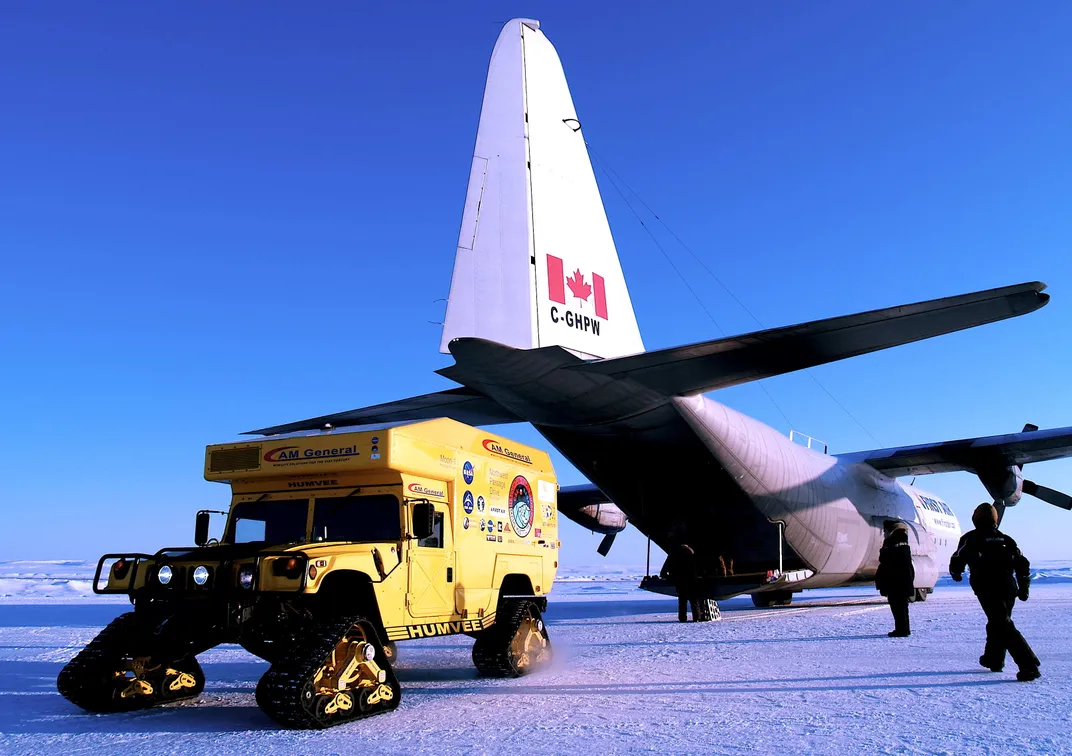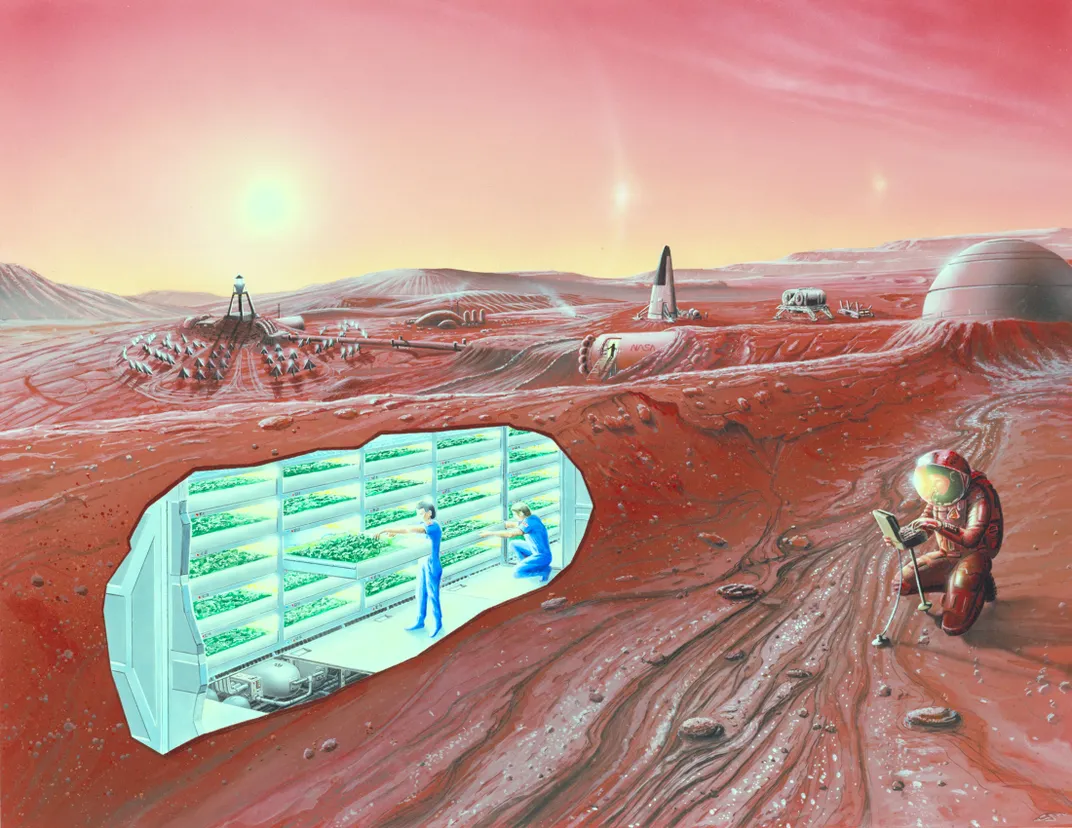When Humans Begin Colonizing Other Planets, Who Should Be in Charge?
The biggest threat humans pose to other worlds is what we don’t know—or what we think we know, but don’t
/https://tf-cmsv2-smithsonianmag-media.s3.amazonaws.com/filer/2a/29/2a299fcc-1bbb-47c0-b0f1-2d349c848ded/pia00407-16.jpg)
Every summer for the past 20 years, Pascal Lee has traveled to the remote Canadian Arctic to pretend he’s on Mars. This cold, dry, pockmarked and essentially lifeless environment is one of the closest to the red planet that you can find on Earth—making it a great practice ground for driving Mars rovers.
Lee, a planetary scientist at the SETI Institute in California, is the director of the NASA Haughton Mars Project, where he uses this analog Mars environment to investigate scientific questions concerning how humans might threaten life on other planets we colonize.
For example, if humans travel to Mars, would microbes transferred from our bodies thrive on Martian soil—threatening native Martian microbes and disrupting native ecosystems? Recent results from Lee’s research suggest the answer to that is no, at least not on the surface of Martian soil: Mars’ harsh climate and high UV radiation would kill off many of the microbes we may accidentally bring from Earth.
But the Haughton Mars Project—along with other Mars analog study sites in Antarctica and the Atacama Desert in Chile—also inadvertently bring to light numerous ethical questions of how we should behave as interplanetary colonists. As humans accelerate their space travel capacity and aim to colonize Mars in the next several decades, these questions are becoming less lofty and more immediately urgent.
Here's another scenario: If humans were to land on Mars and were somehow lethally threatened by Martians, should humans attack the Martians? In his personal opinion, Lee says the answer would be yes. “If at some point it came down to either me or the microbe on Mars that’s going to survive, I’m probably not going to hesitate,” he says.
Yet these are not simple questions to address, and are not within the realm of the Haughton Mars Project to answer. The International Council for Science, consisting of 142 countries, has organized a Committee on Space Research (COSPAR) to help answer some of these questions and a United Nations Outer Space Treaty, in place since 1967, also helps streamline some of the ethical and legal implications that this issue raises.
But the treaty is meant to protect the safety of humans and scientific evidence of life on other planets, not to protect the environments or ecosystems of those planets. Moreover, the contents of the treaty are just guidelines: They are not laws, and the legal implications of not following them remain unclear, says Catharine Conley, head officer at NASA’s Planetary Protection Office.
“The peer pressure approach has, up until now, worked,” she says, explaining that it’s in space agencies’ best interest to work together since they often rely on each other for collaboration and advancement. But now, as more private companies like SpaceX enter the field to visit Mars, the playing field has changed.
“When you have other entities included that don’t have those same long term science objectives, it gets more complicated,” says Conley.

Under the current treaty guidelines, federal governments are responsible for the behavior of both their space agencies and nongovernmental space entities in their country. So a company like SpaceX must be authorized to launch by a government agency before lift off—but if it accidentally or intentionally fails to comply with the treaty guidelines at some point in flight, another country could theoretically sue the U.S. government or take other legal actions, says Conley.
Despite general good intentions and hard work to keep spacecraft free of contaminants, Conley says the biggest threat humans pose to other planets is what we don’t know—or what we think we know, but don’t. While research from the Haughton Mars Project suggests limited microbial transfer from rovers to Mars soil, other dynamics could exist on Mars or other planets that researchers haven’t even thought to anticipate.
“For certain types of Earth organisms, Mars is a gigantic dinner plate,” says Conley. “We don’t know, but it could be that those organisms would grow much more rapidly than they would on Earth because they have this unaffected environment and everything is there for them to use.”
So far, most of the attention to these ethical issues has focused on Mars, the most realistic subject of colonization in the near future. But other types of planets may bring up new concerns. “You can invent all kinds of scenarios, but the problem is currently it’s all open because no one has explored these things before,” says Conley, referring to the legal implications of contaminating Mars or another planet. “So until you have a case, you can’t decide what to do. But of course from the standpoint of planetary protection, as soon as you have a case, something has already gone wrong.”
There are also dangers that fall beyond the realm of planetary protection. Take energy production: In order for humans to live on another planet, we will need to develop a way to produce electricity. A substance called perchlorate exists in relatively high quantities on Mars (and also on Earth in bleach and other substances), making up about 1 percent of all the dust on the red planet. This highly energetic salt could potentially offer a good source of energy for humans on Mars, but not if humans accidentally introduce a microbe that eats it up before we have a chance to use it, says Conley.
Unfortunately, the guidelines put in place by the Outer Space Treaty won’t necessarily prevent this type of mistake from happening. The guidelines are strict on keeping spacecraft clean when looking for life on other planets, but less stringent for spacecraft traveling to a celestial body for other reasons. This is because planetary protection guidelines exist to preserve scientific evidence of extraterrestrial life—not the environments of other planets, says Gerhard Kminek, the planetary protection officer at the European Space Agency.

Working groups of COSPAR, including the Panel on Potentially Environmentally Detrimental Activities in Space, do explore how space activities might disrupt other planets’ environments. These panels report to the United Nations with their findings. But again, they only offer guidelines, not laws, says Kminek. So it’s up to international space agencies to recognize the importance of building best practices in spacecraft sanitation and keeping up with the sometimes onerous standards set by the Outer Space Treaty.
“If you do it badly once, that might be enough to compromise any future investigation related to life,” says Kminek. “And that’s why there is strong international consensus making sure there are no bad players around.”
The standards for travel also differ from one celestial body to another. For instance, Mars atmosphere is thick enough that it will burn off certain microbes upon entry—allowing spacecraft sanitation standards to remain laxer than they would be for vehicles landing somewhere with a very thin atmosphere, like Jupiter’s moon Europa, Kminek says.
That is, at least based on our understanding of these celestial bodies right now. During the Apollo missions to the Moon in the 1960s and 70s, we learned how unforeseen obstacles can cause critical problems in space travel. On the Moon, the threat lunar dust posed to astronauts was underestimated until it started getting stuck in the crevices of their face and in their zippers, jeopardizing the integrity of their spacesuits, says Margaret Race, a colleague of Conley’s at the SETI Institute.
“Had they been up there a little longer, their spacesuits would not have worked,” Race says.
Late astronaut and engineer Eugene Cernan, the last man to have walked on the Moon, stated the enormity of the dust problem during an Apollo 17 technical debrief in 1973: “I think dust is probably one of our greatest inhibitors to a nominal operation on the Moon,” he stated. “We can overcome other physiological or physical or mechanical problems except dust.”
Humans also didn’t do a good job limiting the transport of material from Earth to the Moon or vice versa, says Race. The Moon is lifeless, so this had little consequence on either celestial body. But if the Moon harbored life and a transfer of species did occur, the consequences would have been far greater. “If there were life on the Moon, we would have it here now,” she says. “We did the best we could at the time, but we didn’t understand.”
While space engineering has come a long way since the Apollo missions, plenty of work remains to determine the best practices in protecting life on other planets from humans, says Conley. And when we do finally land on Mars, the advancements will need to continue—even if it appears that scientists have sufficient knowledge of human threat to other planets.
“My response to that is, as soon as you eat your first candy bar, do you stop brushing your teeth?” says Conley. “We should keep doing it.” Because, in the end, what we don’t know will end up being the most dangerous threat humans pose to these other worlds.